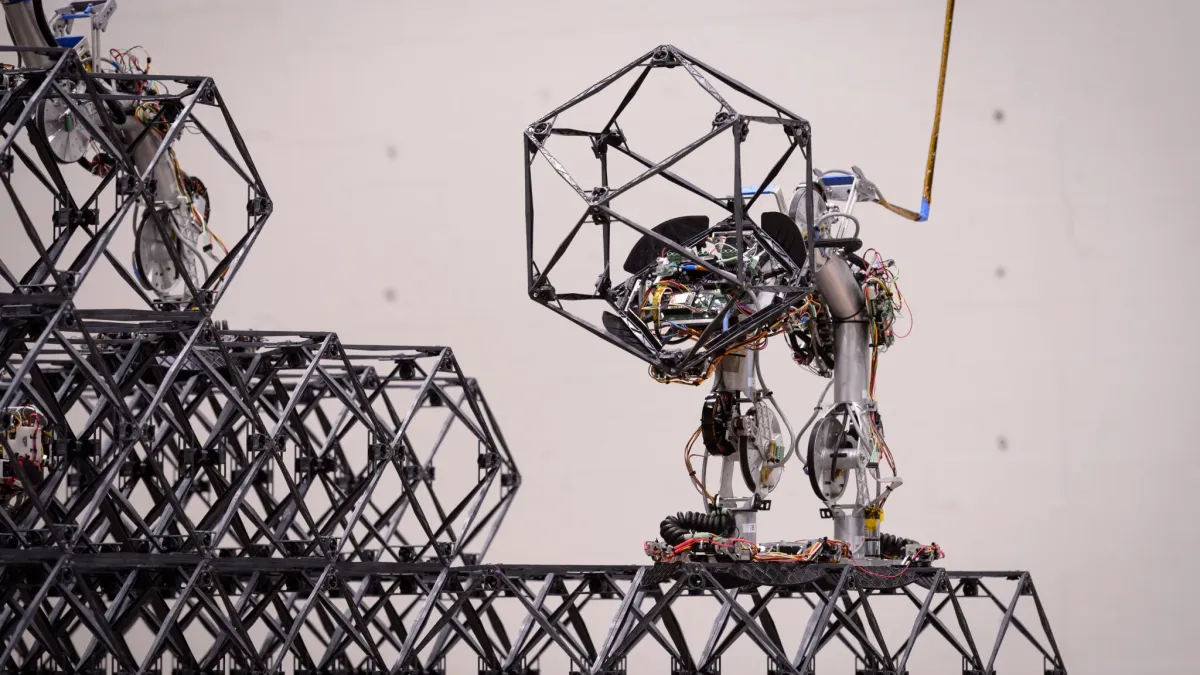Dive Brief:
- As NASA quests to create permanent settlements on the moon, a successful test of autonomous robots may bring that reality one step closer.
- NASA’s Automated Reconfigurable Mission Adaptive Digital Assembly Systems team, which works on autonomous building technology, successfully tested some of that work at the Ames Research Center in Santa Clara County, California, the agency announced on Jan. 17. Three robots built a meters-scale shelter structure — roughly the size of a shed — using hundreds of building blocks.
- The robots used building blocks called voxels, short for volumetric pixels, which can form almost any structure, the agency claims. Concept images show the building blocks made into frames for solar panels on the moon, stabilizing pillars for cave outposts and as the backup for ejecta, or debris, shields on landing pads.
Dive Insight:
The ARMADAS team provided structural plans to the robots, but they didn’t micromanage their work, per the release. Instead, software algorithms did the job of planning the robots’ tasks. The test demonstrated a crucial part of the programs’ capabilities — the system practiced the build sequence in simulation before it started the real run.
While NASA didn’t elaborate on applications for the robots here on Earth, the agency did emphasize the machines’ potential “to build large-scale infrastructure, such as solar power stations, communications towers and habitats,” on the moon or Mars. It also highlighted the ability of bots to build structures “before humans arrive.” The team published its results in the journal Science Robotics.
The voxels are carried by robots called Scaling Omnidirectional Lattice Locomoting Explorers — SOLL-E for short — which can climb and maneuver around the voxels, even when they’re stacked on top of each other.
“Generally, it’s very hard to develop robust autonomous robots that can operate in unstructured environments, like a typical construction site,” said Christine Gregg, ARMADAS chief engineer at NASA Ames, in the release. “We turn that problem on its head by making very simple and reliable robots that operate in an extremely structured lattice environment.”
Cost considerations
During the test, two robots walked along the exterior of the structure, moving one voxel at a time. One was in charge of retrieving the materials before passing them to the second robot for placement. A third robot followed, climbing within the mass of voxels, and bolted them together.
“Making large structures from small building blocks allows us to use good materials at the lowest cost,” said Kenny Cheung, ARMADAS principal investigator at NASA Ames, in the release. “The size of the structures that can be made is only limited by the number of building blocks that can be supplied.”
NASA holds autonomous construction as a key focus ahead of the agency’s planned 2025 manned return to lunar orbit, as part of its Artemis program, before landing humans there again in 2026. Last February, it provided $6 million in funding for academic institutions to research technology that would help create a permanent settlement on the moon, which included autonomous building.












